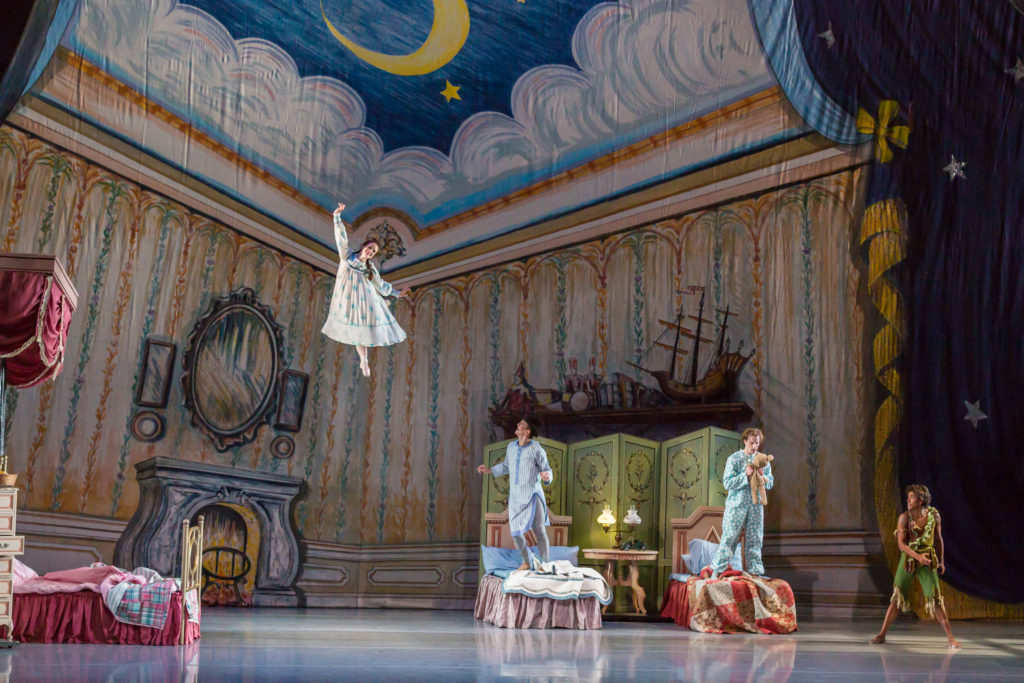
Editor’s Note: Nashville Ballet’s production of “Peter Pan” was cancelled on Friday, October 8 due to a flood caused by a mechanical failure in the James K. Polk Cultural Center. They are currently evaluating the damage and whether they will be able to reschedule the performances.
Dancers are no strangers to flying—they’ve been sylphs and fairies, Wilis and swans, all the while reaching for some sort of antigravitational superpower. But what happens when they have to actually take flight?
Nashville Ballet’s dancers faced this exact question recently when preparing for their upcoming production of Peter Pan. In fact, they had just four weeks to get their flying skills in gear before opening their performance this weekend!
The company’s artistic director, Paul Vasterling, first decided to choreograph a production of Peter Pan in 2013 after reading the original book by J.M. Barrie. “I was drawn to the story, which is about a parent or adult looking back on childhood with longing or nostalgia,” he says. Notably, a lot of that nostalgia is epitomized through Peter, Wendy, Michael, John and Tinker Bell’s ability to fly—which fairy dust enables them to do.
Vasterling’s eventual full-length production was met with critical acclaim in 2013. He later reprised the show in 2015 and brought it to two other companies in 2016 and 2018. Now, it’s all set to take the stage at the Tennessee Performing Arts Center starting Friday, October 8.
Dance Teacher talked with Vasterling and two of Nashville Ballet’s dancers to take you behind the scenes and find out what it took to accomplish this high-flying feat right from start to finish. Hint: It took a lot more than pixie dust!

Flying as a New Dance Language
“We took quite a while to figure out the flying,” says Vasterling. “The concept of how much time it takes to get from point A to point B in the air was unknown to me. But I knew we had to do it.”
To do so, the company hired ZFX Flying Effects to set up a stage flight apparatus in their theater, and Vasterling choreographed off-the-ground sequences for all five flying characters. Backstage, the dancers’ harness systems were pulled and guided by other company dancers, who played the pirates.
When first choreographing the show in 2013, Vasterling spent some time letting the dancers work with the trainer from ZFX to understand the mechanics of the flying apparatus. Then, he had to fit the flight choreography together with the on-ground sequences, like two pieces of a larger puzzle. “It’s a lot easier to teach the dancers the movement once everything is finished,” he says.
In-Air Movement Brings New Challenges
“Ballet dancers are excellent fliers,” says Vasterling. “The point of ballet technique is to resist gravity.” Still, traditional technique relies on a connection with the floor. So exclusive in-air movement comes with new challenges.
“If I lean too far forward, I’ll do a front flip,” says Jaison McClendon, who plays Peter Pan. “And if I lean too far back, I’ll end up doing a backflip.” Although McClendon performs both maneuvers during the show, learning to control his muscles to keep his movements in time with the music took some time. “I have to use my back and my legs to make sure I don’t turn the wrong way,” he says.
Garritt McCabe is one of the two dancers backstage who support McClendon’s flight. The experience has brought its own learning curve, as it’s opened his eyes to the way stagehands allow for the show to go on from behind the scenes. “It’s so educational to know how much work they actually do and the muscles that they’re working throughout,” McCabe says. “My hands actually have calluses because of how I’m gripping the rope, and so I’ve had to learn my own version of the choreography in order to be able to focus on engaging the right muscles to pull the rope correctly.”
Bringing the Ballet Back to Life
This weekend marks many firsts for Nashville Ballet—it’s the company’s first performance back in a theater since the onset of the pandemic, and it marks the opening of McCabe’s first season. In many ways, the show has expedited his ability to make connections with his new fellow company members.
“Being back in the studio and dancing with the whole company just feels so great,” says McCabe. “Having the opportunity to help Jaison fly helped us connect more, and I don’t think I would have been able to communicate with so many people had I not had an opportunity like this.”
While flight choreography might seem like a big project to take on after such a long time apart, the dancers agree that it helped establish the specialness of this production. “We were able to just talk through things and bring this ballet to life,” adds McClendon.
This point is not lost on Vasterling, either—that’s why he chose to have the dancers support one another. “They work in very trusting relationships,” he says. “They literally have each other’s back.”




